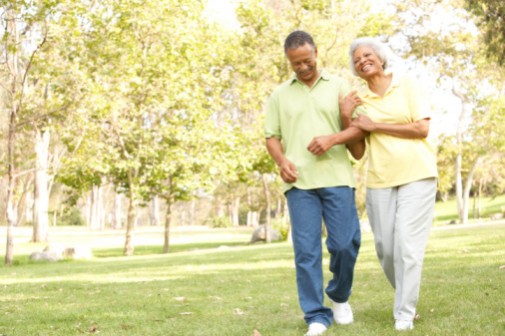Diabetes: Walk away your risk

For older adults, a short 15-minute walk after every meal lowers blood sugar and the risk of Type 2 diabetes, a new study reveals.
According to research, published in the June issue of the journal Diabetes Care, three brief post-meal walks have proven to control blood sugar levels better than one 45-minute walk in the morning or evening hours, claimed lead researcher Dr. Loretta DiPietro, in a statement.
More importantly, the post-meal walking was significantly better at lowering the post-dinner glucose level than 45-minute walks in the morning and evening times, said Dr. DiPietro, chairwoman of the George Washington University School of Public Health and Health Services in Washington, D.C.
The after-dinner period is an especially vulnerable time for older people at risk of diabetes, DiPietro said. Insulin production decreases, and seniors may go to bed with extremely high blood glucose levels, increasing their chances of diabetes.
According to the American Diabetes Association, a whopping 79 million Americans are at risk for Type 2 diabetes, a condition in which the body does not produce insulin or does not use insulin effectively. Factors such as being overweight and/or sedentary increase the risk for Type 2 diabetes. According to DiPietro’s research, brief walks can lower diabetes risk if they are taken soon after consuming a meal.
The study did not, however, prove that the walks caused the improved blood sugar levels.
“This is among the first studies to really address the timing of the exercise with regard to its benefit for blood sugar control,” she said. In the study, the walks began a half-hour after finishing each meal.
For the purpose of the study, DiPietro and her colleagues asked the 10 older adults, aged 70 years old on average, to complete three different exercise routines spaced four weeks apart. At the study’s start, the men and women had fasting blood sugar levels of between 105 and 125 milligrams per deciliter. A fasting blood glucose level of 70 to 100 is considered normal, according to the U.S. National Institutes of Health.
The men and women stayed at the research facility and were supervised closely. Their blood sugar levels were monitored the entire 48 hours.
On the first day, the participants did not exercise. On the second day, they did, and those blood sugar levels were compared to those on the first day.
The men and women were classified as obese, on average, with a body-mass index (BMI) of 30. Participants walked on a treadmill at a speed of about 3 miles an hour (a 20-minute mile, which DiPietro described as the lower end of moderate).
The walks after meals reduced the 24-hour glucose levels the most when comparing the sedentary day with the exercise day. A 45-minute morning walk was next best.
Walking after dinner was much better in reducing blood glucose levels than the morning or afternoon walking, DiPietro found.
Walking a half-hour after eating gives time for digestion first, DiPietro said. Within that half-hour, she said, “the glucose starts flooding the blood. You are using the working muscles to help clear the glucose from the blood stream.” The exercise “is helping a sluggish pancreas do its job, to secrete insulin to clear the glucose,” she said.
The briefer, more frequent exercise may also sound more doable to sedentary older adults, she said. “Committing to do this with someone would work best,” DiPietro said. “It can be coupled with things like walking the dog or running errands.”
The findings are quite practical, said Dr. Armand Krikorian, internal medicine program director at Advocate Christ Medical Center in Oak Lawn, Ill.
“Exercising after meal consumption causes the blood sugar to drop because more of the glucose goes to the muscles to help them with their metabolism,” said Krikorian. Additionally, the light walking helps the pancreas to do its duty, by clearing the glucose into the muscles.”
DiPietro cautioned, however, that “you have to do it every day” to get the benefit. It’s not a prescription for fitness, she said, but simply to reduce diabetes risk.
Related Posts
Comments
About the Author
health enews staff is a group of experienced writers from our Advocate Health Care and Aurora Health Care sites, which also includes freelance or intern writers.

















